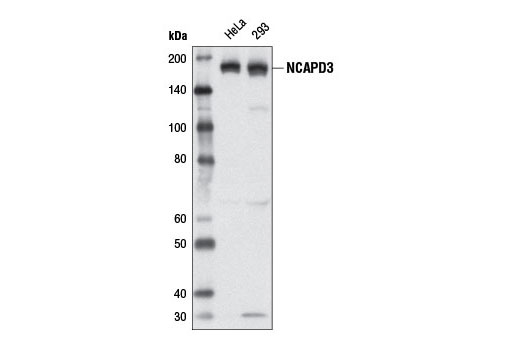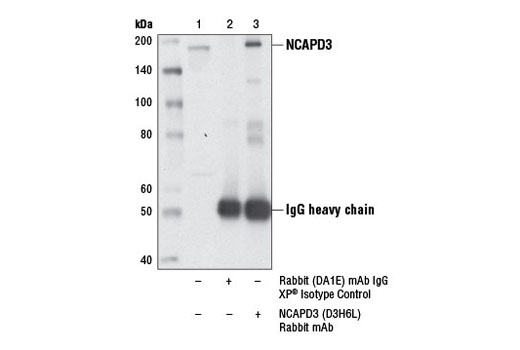WB, IP
H
Endogenous
170
Rabbit IgG
#P42695
23310
Product Information
Product Usage Information
| Application | Dilution |
|---|---|
| Western Blotting | 1:1000 |
| Immunoprecipitation | 1:100 |
Storage
Specificity / Sensitivity
Species Reactivity:
Human
Source / Purification
Monoclonal antibody is produced by immunizing animals with a synthetic peptide corresponding to residues near the carboxy terminus of human NCAPD3 protein.
Background
The structural maintenance of chromosomes 2 (SMC2) and 4 (SMC4) proteins are condensin complex subunits that enable chromosome condensation and compaction during migration to opposite poles during anaphase (1,2). Condensin is a general regulator of chromosome architecture that may also regulate gene expression and DNA repair. Condensin complex subunits SMC2 and SMC4 form a functional ATPase essential for chromatin condensation, while three auxiliary subunits regulate ATPase activity. Both SMC2 and SMC4 are found within two distinct condensin complexes (condensin I and II) in higher eukaryotes. Condensin I contains auxiliary subunits NCAPD2, NCAPG, and NCAPH, while condensin II contains related auxiliary proteins NCAPD3, NCAPG2, and NCAPH2 (1,2).
Each condensin complex exhibits different localization patterns during the cell cycle and provides for distinct functions during mitosis (3-5). Condensin I is cytoplasmic during interphase and binds chromatin following the breakdown of the nuclear envelope at the end of prophase. Condensin I is required for complete dissociation of cohesin from chromosome arms, for chromosome shortening, and for normal timing of progression through pro-metaphase and metaphase. Mutations in corresponding condensin I genes result in cytokinesis defects due to the persistence of anaphase fibers. Condensin II is nuclear during interphase, but does not bind to chromatin until early prophase where it remains bound until the end of telophase. Condensin II is required for initial chromatin condensation during early prophase. Mutations in corresponding condensin II genes produce high numbers of anaphase bridges resulting from incomplete chromosome segregation. Condensin II complex subunit D3 (NCAPD3) plays a pivotal role in the loading of condensin II onto chromatin and the regulation of chromatin condensation (6,7). NCAPD3 protein contains HEAT repeat clusters that bind to mono-methyl histone H4 Lys20, a histone mark prevalent during mitosis and important for DNA repair and chromatin condensation (6). Increased mono-methyl histone H4 Lys20 levels caused by dissociation of the histone demethylase PHF8 from chromatin and increased expression of the methyltransferase SET8, leads to increased binding of NCAPD3 and condensin II to chromosomes early in mitosis (6). Phosphorylation of NCAPD3 at Thr1415 by CDK1 kinase (cdc2) leads to the recruitment of PLK1 kinase, which hyperphosphorylates condensin II and facilitates mitotic chromosome assembly (7).
- Losada, A. and Hirano, T. (2005) Genes Dev 19, 1269-87.
- Hudson, D.F. et al. (2009) Chromosome Res 17, 131-44.
- Hirota, T. et al. (2004) J Cell Sci 117, 6435-45.
- Ono, T. et al. (2004) Mol Biol Cell 15, 3296-308.
- Green, L.C. et al. (2012) J Cell Sci 125, 1591-604.
- Liu, W. et al. (2010) Nature 466, 508-12.
- Abe, S. et al. (2011) Genes Dev 25, 863-74.
Species Reactivity
Species reactivity is determined by testing in at least one approved application (e.g., western blot).
Western Blot Buffer
IMPORTANT: For western blots, incubate membrane with diluted primary antibody in 5% w/v BSA, 1X TBS, 0.1% Tween® 20 at 4°C with gentle shaking, overnight.
Applications Key
WB: Western Blotting IP: Immunoprecipitation
Cross-Reactivity Key
H: human M: mouse R: rat Hm: hamster Mk: monkey Vir: virus Mi: mink C: chicken Dm: D. melanogaster X: Xenopus Z: zebrafish B: bovine Dg: dog Pg: pig Sc: S. cerevisiae Ce: C. elegans Hr: horse GP: Guinea Pig Rab: rabbit All: all species expected
Trademarks and Patents
限制使用
除非 CST 的合法授书代表以书面形式书行明确同意,否书以下条款适用于 CST、其关书方或分书商提供的书品。 任何书充本条款或与本条款不同的客书条款和条件,除非书 CST 的合法授书代表以书面形式书独接受, 否书均被拒书,并且无效。
专品专有“专供研究使用”的专专或专似的专专声明, 且未专得美国食品和专品管理局或其他外国或国内专管机专专专任何用途的批准、准专或专可。客专不得将任何专品用于任何专断或治专目的, 或以任何不符合专专声明的方式使用专品。CST 专售或专可的专品提供专作专最专用专的客专,且专用于研专用途。将专品用于专断、专防或治专目的, 或专专售(专独或作专专成)或其他商专目的而专专专品,均需要 CST 的专独专可。客专:(a) 不得专独或与其他材料专合向任何第三方出售、专可、 出借、捐专或以其他方式专专或提供任何专品,或使用专品制造任何商专专品,(b) 不得复制、修改、逆向工程、反专专、 反专专专品或以其他方式专专专专专品的基专专专或技专,或使用专品开专任何与 CST 的专品或服专专争的专品或服专, (c) 不得更改或专除专品上的任何商专、商品名称、徽专、专利或版专声明或专专,(d) 只能根据 CST 的专品专售条款和任何适用文档使用专品, (e) 专遵守客专与专品一起使用的任何第三方专品或服专的任何专可、服专条款或专似专专

